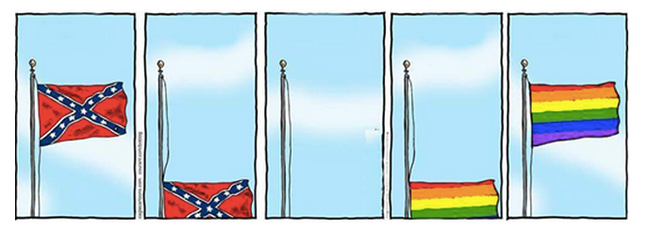A Tale of Two Flags
The past three weeks in campaigning have been dominated by symbols. One, a symbol of racism, hatred and intolerance. The other, unity, inclusiveness and acceptance. The rainbow flag of gay pride rose high and took over all your friends’ Facebook profile photos. The confederate flag went from hotly debated “Southern heritage,” to an unacceptable (and un-sellable) relic of racism. Massive corporations were updating their websites with rainbow logos while simultaneously removing Confederate flag products.

Some activists have rightly cautioned against drawing direct parallels, but the conclusion we can draw is that symbols, icons, brand marks matter. In my humble opinion, the important progressive change-driving groups of our era are lacking this vital component of their identity.
Making the Private Public #
Social media definitely played a critical role in the rise of the rainbow flag and demise of the stars and bars. In trainings and storytelling workshops we repeat a mantra, “Making the private public.” Jonah Berger’s Contagious: Why Ideas Catch On outlines the STEPPS to sticky content, which hinge on ideas and symbols that represent a person’s values. The question to ask: “Does sharing this content or icon showcase my values?” In the case of both flags – yes, which is why one is ubiquitous and one is unacceptable.

The gay rights movement as a whole and Human Rights Campaign in particular have used flags and other icons to make the private public…the silent majority visible. On the other hand, campaign organizations like MoveOn.org, Avaaz and NGOs have not. The great success stories of digital native campaigning failed to develop a meaningful identity to coincide with their progressive actions.
I’ve signed hundreds of MoveOn petitions; I even worked for the organization at one point, but I’d never identify myself as a “MoveOn-er,” or whatever the appropriate identifier (my point exactly). Conversely, I’ve met Conservatives who have done nothing more than share a Sarah Palin post on Facebook, but quickly identify as members of the “Tea Party.”
In the Beginning… #
What do they have that we don’t? To begin with they have a Creation Story. I emphasize “story.” Tea Partiers believe their movement began organically with a rant by CNBC’s Rick Santelli, followed by online and offline rallying. More likely, it was astroturfing by Big Tobacco and the Koch Brothers.
Contrast their story to “MoveOn,” which was founded to prod Congress to censure Bill Clinton and just “Move on.” Post-Clinton, there is actually a pretty incredible creation story about millions of people spontaneously rising up against George W. Bush’s policies and rallying under the MoveOn banner. The movement was so passionate and its rise so meteoric that it actually led to the creation of Avaaz. What a story! Unfortunately, you won’t see that on MoveOn.org. You will see:

MoveOn is a community of more than 8 million Americans from all walks of life who use innovative technology to lead, participate in, and win campaigns for progressive change.
Umm, change your profile picture to that?
The big NGOs aren’t off the hook either. WTF is Oxfam?
We are a confederation of affiliates, seeking maximum impact by building on our respective strengths. By working together, we enhance our collective impact and cost effectiveness, and contribute to a just world without poverty.
Great. What? I’ve always thought Oxfam had an incredible creation story that explains exactly who they are, what they believe, what they do and why they do it.
My version:
Oxfam represents a shortening of our original name, “Oxford Famine Relief.” A group of slightly religious humanitarians met in a room in Oxford and decided we should help WWII refugees. We did and millions of people pitched-in. We continued helping those in need and turned our blanket and clothing collection points into second-hand shops that raised money for the poor and marginalized. As we grew, we shortened our name, added more partners in the countries we were working, and learned that humanitarian relief wasn’t enough. We started campaigning to change the systems and stop the conflicts that cause poverty and suffering. We are doing our best to end extreme poverty and inequality caused by past and present colonialism and corporate greed. Want to help?
Social Code of Movement Identity #
Wait, wasn’t I talking about flags? You got me! Here’s the thing: icons can’t be separated from identity; identity can’t be separated from creation story, creed and values, ritual, lexicon, and leaders. ISIS knows this.
The social code of identity is vital to the growth of movements, and leads to the hardest part for many of the “Poverty is bad” organizations – differentiation. In brand movement speak, the term is “nonbelievers.” The sad truth is that meaningful identity serves to separate your supporters from your antagonists. The icons represent values, and not all will share those values, which is why the yellow and white wristbands were nice, but fleeting.
Strong identities, like the rainbow flag or the Confederate flag for that matter are provocative and immediately signal values. Those values separate the movement from others, with an ultimate goal of saying, “We are loud and proud.” At some point, “We are many.” What it doesn’t say is, “We are a coalition of diverse groups using technology and other tools for change.”
Finding Our Flag #
The campaigns we run and actions we ask supporters to take do support our movement identity, but they aren’t enough. We need authentic symbols that signify values and spring from our creation stories…our roots. Or, as the creator of the rainbow flag said recently,
We needed something that expressed our beauty, our soul, our love — that came from us and wasn’t put on us.
Yes. That’s exactly what we need.